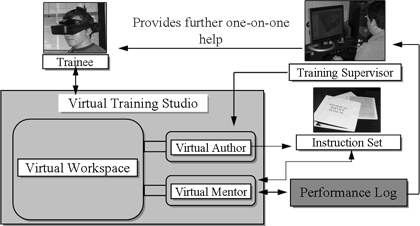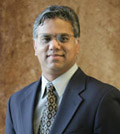Dr. Satyandra K. Gupta
Professor
Mechanical Engineering and
Systems Research Departments
Virtual Training Studio: A Virtual Environment-Based Training System
for Mechanical Assembly Operations
Click here to view VTS images as the user would see them
Click here for more information on this project
Training in Virtual Environments Book
The Virtual Training Studio (VTS )which Dr. Gupta and his team have developed is a virtual environment-based training system, which aims to improve existing training methods through the use of a virtual environment-based multi-media training infrastructure. This infrastructure allows users to learn through different modes of instruction presentation, while focusing mainly on cognitive aspects of training as opposed to highly realistic physics-based simulations.
The VTS system has two main goals. The first goal is to ensure that virtual environment-based instructions for training personnel in the manufacturing industry can be created quickly, so an overall training cost reduction can potentially be realized through the use of our system. The second goal is to accelerate the training process for the trainees through the use of multi-modal virtual environment-based instructions.
The VTS is composed of the following three modules: Virtual Workspace, Virtual Author, and Virtual Mentor.

VTS Architecture
Virtual Author
Virtual Author is a component of the VTS that allows non-programmers to quickly create new tutorials, which are later executed inside the virtual environment. The instructor creates tutorials by loading CAD models into a virtual environment and performing a virtual demonstration of the assembly process. The Virtual Author also generates text instructions by analyzing the instructor’s motions, collisions between objects, and feature alignment.
Virtual Workspace
Virtual Workspace provides the underlying virtual environment multi-modal infrastructure. It supplies the platform for the other two modules to function and integrates the hardware and software into a cohesive package. This module loads tutorials created by the Virtual Author and executes them inside the virtual environment. The Virtual Workspace breaks down the assembly process into individual steps and allows each step to be completed using an animation sequence, interactive simulation, or video of the actual process.
Virtual Mentor
Virtual Mentor is a module, running on top of the Virtual Workspace, which checks for user errors, assists users in the training process and provides additional details to further clarify the action required. This module is not only responsible for the content of the messages to the trainee, but also the appropriate presentation of content to the user.
Benefits
There are a number benefits from the use of the Virtual Training Studio. First, the number of personnel required to become trainers is reduced, since the system will perform the bulk of the training. Second, the systeml provides a convenient mechanism for depositing assembly process knowledge into a central repository for later retrieval by trainees, trainers, and managers. Third, the VTS assists instructors in the creation of VE-based tutorials and paper-based documentation by generating an instruction set from the animation sequence and by providing a convenient way of generating 2D illustrations. Fourth, the system provides an affordable Personal Virtual Environment. The most important benefits, however, is an accelerated learning process as well as a reduced probability of worker error.


